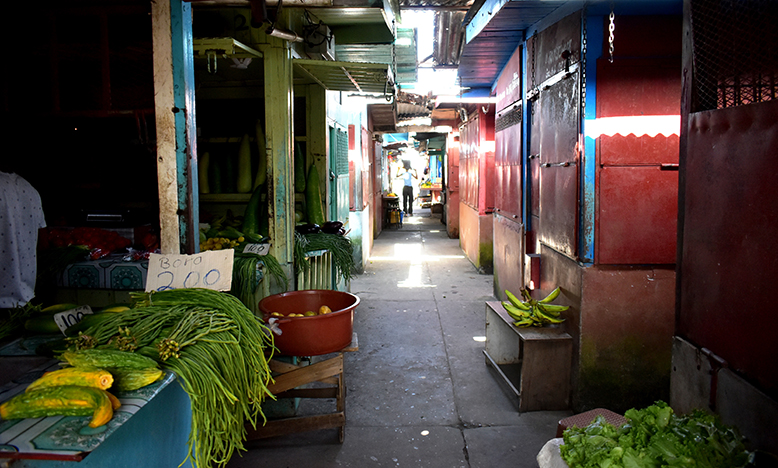FOR a while, there have been complaints from citizens about the increasing costs for vegetables at the markets, but market prices for ‘greens’ appear to be returning to more affordable costs.
The Guyana Chronicle visited the Bourda Market and spoke with vendors who confirmed the decrease in prices of some items. For these vendors, prices are set based on how much they purchased the goods for or other circumstances.
A vendor located deep within the market between Robb Street and North Road, and Orange Walk and Bourda Street said, on condition of anonymity, that stallholders inside of the market are hardly getting sales because of the many roadside vendors.
“The road sellers,” she said, “they have a scheduled time that they have to close up selling out there… They selling retail and wholesale as one price. And now when you buy on the road and come in the market, the customers claiming they buy it for cheaper on the road, and it does kill the market sellers.”
Several stalls were closed during this newspaper’s visit. One vendor told the Guyana Chronicle that most sellers have abandoned their stalls inside the market and opted to sell on the roadside. They blamed difficulties with sales.
She explained that goods sometimes have to be resold at a cost similar to how much vendors themselves paid for it. This not only results in a loss, but could also result in produce being wasted, if there are no sales for that day.


The vendor also noted that there has been a decrease in the sale of tomatoes, as there is a cheaper-priced foreign variety on the market.
Local tomatoes are usually sold at $600 to $700 per pound, while the foreign tomatoes are sold at $400 per pound, prompting vendors to either sell their local tomatoes at a lower price, or resell them for the same price they would have purchased them for.
Another vendor, Felicia Persaud, said the price for ‘greens’ went up during the May-June rainy season, but has since fallen.
Explaining the difficulty of selling within the market while others flock to the road, Persaud said that the vendors on the road would pay some vagrants to dispose of garbage. The vagrants, however, would dump the waste in front of closed up stalls within the market.
“All these stand them what you see close up, tomorrow morning when you come is each one got garbage.
“The people on the road send the ‘junkie’ with the garbage, and the ‘junkie’ don’t want to throw it away; they does throw it in the market. So this does be going on all the time,” she said.
CALL TO ACTION
Persaud is pleading with the government to ensure that the stalls in the market are being occupied, so that the persons inside of the market can acquire sales in a structured way, since they are still required to pay rent.
Persaud further called for proper sanitation facilities, including water and toilet facilities.
Another vendor located along the roadside told this newspaper that compared to two weeks ago, prices for goods have declined. She said a pound of ochro sold previously for $340, but is now $300.
Additionally, when comparing the prices seen inside and outside the market, the prices for ‘greens’ on the roadside were either the same as within the market or more expensive.
The Guyana Chronicle also visited a city supermarket, which reflected higher prices for ‘greens’ when compared to small vendors in the market.
While a bundle of bora sold for $200 at Bourda Market, a similar bundle sold for $250 at the supermarket. Ochro was priced at $375 at the supermarket, while the price was $300 at Bourda Market.
In efforts to reduce the high cost of living in Guyana, government had made many interventions.
Some $7.5 billion was expended on the COVID-19 cash grants alone up to January 2022.
Once completed, the programme was expected to see each household in Guyana benefitting from a one-off grant valued at $25,000.
President, Dr. Irfaan Ali indicated in January 2022 that under the People’s Progressive Party/Civic (PPP/C) administration, each of the 10 Administrative Regions has benefitted from the programme, “…injecting critical liquidity into the economy and providing a cash lifeline to households, so many of which were thrown into distress as a result of the pandemic.”
Additionally, the government distributed $1 billion in fertilisers to farmers all across Guyana as a means of absorbing the rising global costs for the commodity, and preventing the costs from being passed on to consumers at the market.
“The cost of a fertiliser has affected the production cost[s] for farmers which have translated into increased prices in the markets.
“In order to cushion the impact of the rising cost of fertiliser on farmers, and to limit the pass through to food prices, my government will be purchasing $1 billion dollars’ worth of fertiliser for free distribution to farmers for use in their planting activities,” Dr. Ali had declared in May 2022.


